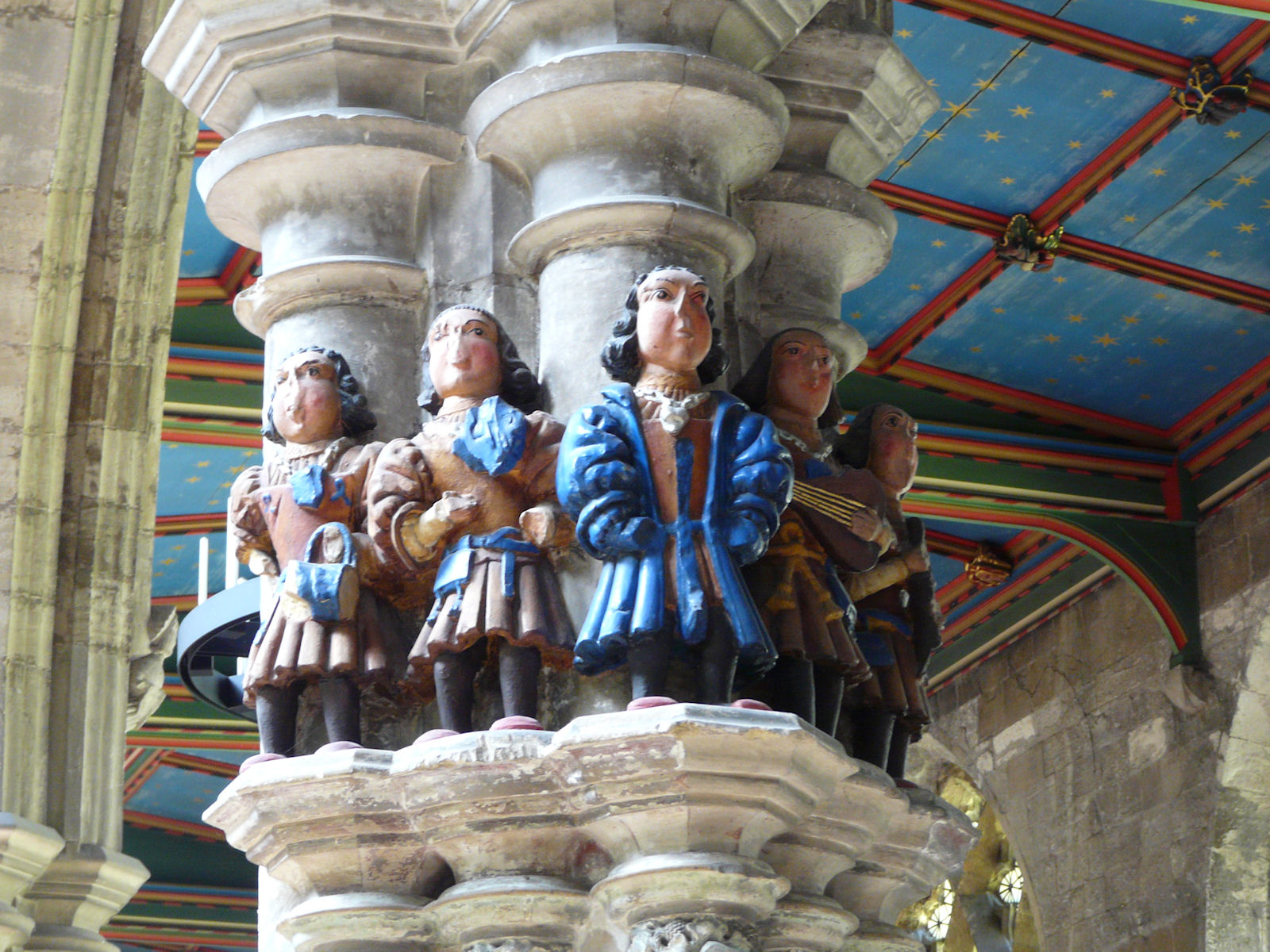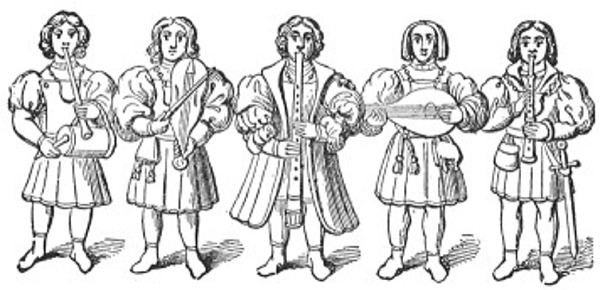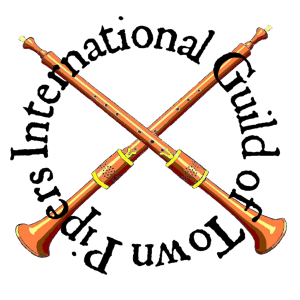The Minstrels’ Pillar in St. Mary’s Church, Beverley –
a Tudor portrait of the York waites? Photographs of the Minstrels’ Pillar at St Mary’s Church, Beverley.
James Merryweather
Summary
Most English towns and cities, like their European counterparts, supported a band of musicians: the waites. They were, without doubt, familiar to all inhabitants, for they patrolled the streets in the early morning – Past three, fair frosty morn. Good morrow my masters all – playing music as they performed their night watch duties as well as in civic pageantry. There are surprisingly few illustrations of them, indeed only one contemporary picture is currently known, a drawing from the third quarter of the 17th century which is now in the Pepysian Library in Magdalen College, Cambridge. The affiliation of the waites depicted is unclear, but we may reasonably guess that they are one of the London bands, perhaps specifically the Westminster waites, as they are included in a collection of London and Westminster Prints and Drawings. The Minstrels Pillar in Beverley may be a second contemporary illustration of waites, and it is possible to extend previous interpretation of the carving because the scutcheons on these musicians’ chains of office have a singular shape, that of those belonging to the waites of the city of York.

Introduction
When the tower of St. Mary’s church in Beverley, North Yorkshire collapsed in 1520, the nave was also seriously damaged. A number of benefactors helped finance rebuilding, and carved heads above the pillars of the north arcade record their contributions.
The capital of the easternmost pillar, opposite the pulpit, is surmounted by a unique group of five musicians carved in stone, a monument given by the Northern Guild of Musicians during the rebuilding of 1520-24. Above them on the pillar is the inscription: Thys Pyllor made the meynstyrls [sic] and on the reverse: Orate pro Animabis Histeriorum. The carvings are remarkably well preserved, considering that other church memorials in St. Mary’s, as elsewhere, were ravaged during the civil wars, but even so, most of the instruments held by the musicians have been damaged or lost. This discussion must rely heavily upon published descriptions which are frequently flawed, and, therefore, will require careful interpretation.
The carved figures are painted, sympathetically, but possibly using the incorrect colours. It was hoped that early descriptions might provide reliable evidence of original coloration, the most detailed of which is provided by Poulson1 . Oliver2 who, like Poulson wrote in 1829, gives a perplexingly different description. Further confusion is supplied by Brereton3, who states that the colours were scarlet & blue, which were by the time of his description in 1865 subdued…. by time so as to be ….passably good now suggesting that the figures were painted some time before, perhaps prior to 1829.
Illustrations and descriptions of the St. Marys minstrels are commonly to be found in guide books and histories1,2,3,4,5,6, but none provides a convincingly authoritative discussion of the origins and identities of the gentlemen depicted, tending to describe them as e.g. The Guild of Musicians6 or simply Minstrels with limited qualification. There may be sufficient information in the figures themselves for a more precise interpretation to be attempted.
Figure 2
Coloration of the carvings on the minstrels’ pillar in St. Mary’s church, Beverley.
| Poulson, 1829 | Oliver, 1829 | 1998 | |
| Top-coat (central figure only) | Tawny | – | Blue |
| Coat/Doublet | Tawny | Blue | Tawny |
| Shirt | White or buff | – | Tawny |
| Hose | Black or brown | Red | Black |
| Shoes | Red (central figure) | – | Red-brown |
| Belt or | Blue | Yellow (girdles) | Blue |
| Rope (minstrel 4) | – | – | Buff |
| Bag | Blue | – | Blue |
| Chain | Yellow | – | Silver |
| Scutcheon | Blue | – | Blue |
| Hair | Black | – | Black |
| back |
The heads and faces of these musicians are all similar (though not identical), youthful and sexless, but they are clearly dressed as men, and the figures contain plentiful information. They have wavy or straight hair which is bob-cut above the shoulder and each wears a collarless, puff-sleeved, skirted (livery) coat, a shirt with round, decorated neck-line, and broad-toed shoes. There is one other illustration of household musicians of this period, that by Hans Holbein of Henry VIII’s wind band (Figure 3), and their dress is strikingly similar7
The Figures – Their Clothing And Instruments
The central figure (Minstrel 3) stands out as different, apparently more senior than the other four. His hair has an extra wave and, uniquely in the group, he wears an open top-coat, belted, with sleeves puffed from shoulder to wrist. Beneath, like the other four, he wears a skirted coat or doublet which ends above the knees of his hose-clad legs. Poulson1 (1829) and Brereton3 give his instrument as a harp. However, we have a fair indication of just how little of the instrument remained then as now, for it is reported that he once held a bombarde6 as is shown in the unattributed reconstruction in Scholes8,9
The other four musicians, two on either side of the (?)harper, are all of similar dress and appearance, differing only in detail of belt, purse, instrument etc. Their hair-style is slightly less extravagant than that of the central figure. They have no top-coat, but their coat is a little longer than that of the central figure, ending below the knee, and sleeves puffed only to the elbow. Because of the lack of top-coat one can see that the coat breast is closed, the front panel tied neatly with a single-bowed point (a tie used to keep separate items of clothing together, e.g. doublet and hose) in the hollow of each shoulder.
Variation is as follows (left to right):
Minstrel 1 has at his waist a narrow, flat belt with the long end, which emerges from an unseen buckle, loops behind and over the belt, hanging vertically down. No purse or bag is visible. The belt supports the remains of a small drum which is held almost at 90 to the usual attitude, in the manner of a player of pipe and tabor which is reasonably depicted in reconstructions3,8. The three-holed pipe is missing, but his mouth retains fragments of its mouthpiece.
Minstrel 2 also has a flat belt from which hangs a substantial bag with a pair of tasselled pull-down closure cords. His instrument is supposed to have been a violin1,4(3,8) of which unrecognisable fragments adhere to his chest. A violin may well be correct as the instrument would have been around at the time, having emerged from Italy around 1500, and it rapidly gained popularity as it spread throughout Europe. Other less likely instruments have been proposed: tenor viol6 and crowth2 (crwth or crowd)10
Minstrel 4 has the waist of his coat belted with a neatly knotted rope with a bag like that of 2. He is a left-handed player (artistic license or direct observation?) of a plucked string instrument which may be a cittern or a simplified lute.
Minstrel 5 has a bag like 1 and 2, but his belt also supports a short sword. The instrument he once held is uncertain, for little remains as evidence bar the positioning of his hands, right above left, and fragments adhering to hands and mouth where the instrument has been broken away. It was a wind instrument, but no author has given a convincing interpretation, naming it variously: piper [sic]1, treble flute2, flute3, pipe4 and hautboy or oboe6. It is likely to have been either a soprano shawm9 or a largish, perhaps tenor, recorder which in England would have often been known simply as aflute.

Insignia
The most important feature in consideration in this discussion of the identity of the St. Mary’s minstrels is the chain of office which hangs around each figure’s neck. The chains are all made of rectangular links from which depends a scutcheon, the badge of cognizance. In reality, the scutcheon would have borne a heraldic device, the badge of the musician’s patron11. Since the scutcheons are blank, we might presume that the square links similarly do not literally represent real links which, in civic insignia are usually heraldic, and thus very complicated, a substantial challenge to the sculptor. As in his appearance, the central figure also differs from the others in that his scutcheon is small and roughly heart-shaped with irregular bumps upon it. It is said that he is the President6 or Alderman1,12,13 of the Northern Guild of Musicians, that this badge was already more than a century old when the minstrels’ pillar was erected, and that early in the seventeenth century itwas given to the town of Beverley to be worn on formal occasions by the Mayoress6. I have no argument with this conclusion, but note that the mayoress ceased to wear one of the old waites’ chains in 197614. This scutcheon does not resemble any of those on the three extant Beverley waites’ chains14.
The scutcheons or badges worn by the other four musicians (1,2,4 and 5) are very different from that of their Alderman, yet all of the same design. They have a flat, unfigured surface with no detail of the arms, which they undoubtedly would have borne in reality, is discernible. However, the outline is very distinctive and clear, even on 2 where it has been caught up by his instrument and tugged aside. Illustrations and originals of extant waites’ chains have been examined and none but those of York bear any resemblance to those worn by the St. Mary’s pillar minstrels11,14,15,16,17,18,19. The three Beverley waites’ chains, two of which almost certainly predate the pillar (they were de novo factis in 145213)20, have a simple shield outline14,16.
Liveries
The original or early colour of the minstrels’ coats is not clear, for Poulson1 and Oliver2, both writing in 1829, give respectively tawny andblue. When Brereton3 gave the colours as (faded) scarlet & blue in 1865, did scarlet refer to the coats? In so idiosyncratic anaccount21, surely the author was describing major features, such as the coats? From the early 17th century onward, the York waites coats were scarlet15,22 and it is probable that they were scarlet in the 16th century too, for red and white were the city’s colours from the 15th century, (e.g. the St George cross on the arms of York and also the ancient cap of maintenance) and the city’s officers’ liveries were universally scarlet. The current coat colour at St. Mary’s, Tawny, would have been correct for the Beverley waites’ from 150213 as well as in 18291 when the waites could still be seen and heard in Beverley, 8 years before country-wide abolition by the Municipal Corporations Reform Act of 183615 It would be interesting to search for scraps of original paint beneath the tawny, if the authorities of St. Mary’s would permit. With a coat of paint, the colour of the minstrels’ coats could have been changed to tawney at any time in the history of theminstrels’ pillar, but the singular shape of their scutcheons could not, and must be a reliable hint to the minstrels’ identity.
Conclusions
Were it not for the shape of their scutcheons – the home town identity badges of English waites and treasured property of their employing councils11,23 – there would be no reason but to accept that the St. Mary’s minstrels represent the Beverley waites accompanying their guild Alderman. However, on currently available evidence, the scutcheons depicted can only be those of York, and I propose that the four minstrels on the Beverley pillar are based on the York waites and that their coats may once have been red. A possible objection to this attractive conclusion is that, at the time the pillar sculpture was erected, York supported only three waites15,22, and the band did not increase to four until 1566-715,22. This matters little, for there were also three waites in Beverley in the 1520s13 and they did not become four until 178524. Our anonymous sculptor may have had to invent a fourth waite in order to create symmetry in his art.
NOTES
1. Poulson G. (1829). Beverlac. London & Oxford.
2. Oliver G. (1829). The history & antiquities of the town and Minster of Beverley in the county of York.
3. Brereton C. (1865). A paper read to the Yorkshire Architectural Society at Beverley, June 20th, 1865. Published by Yorkshire Architectural Society.
4. Binnington E. (1905). Church guide: St Mary, Beverley.
5. Fletcher JS. (1901). A picturesque history of Yorkshire. Dent & Co., London.
6. Smith WCB. (1979). St. Mary’s Church Beverley. The current church guide. Jarrold, Norwich.
7. Hogwood C. (1977). Music at court. The Folio Society, London.
8. Scholes P. (1944). The Oxford companion to music. 5th ed. Oxford.
9. No explanation of the term bombarde is given6, and it was one used on the continent but not usually in England. The instrument was probably that known as the “tenor shawm” (which, confusingly, we today call the alto), a member of a family of double reed woodwind instruments in regular use at the time. [The soprano shawm was known in England as the “hautboy”, a French term which, in the 18th century, became “oboe”, into which it developed]. As the figure is today, there is no helpful evidence visible of any instrument at all, even at his mouth, which might possibly be described as being in a blowing attitude. Two of the other figures (1 & 5), who more probably held mouth-blown wind instruments, do have remnants adhering to their lips. His hands are missing but, were they not, they would be opposite one another. This attitude is reasonable for holding a harp, but not for holding a bombarde, for which the hands would be one above the other, as is the case of Minstrel 5. It seems to be reasonable to rely on the descriptions which give it as a harp, with which writers of 1829 could not be mistaken (as they can with longredundant instruments, such as the shawms, which have been frequently misunderstood in older works published before knowledge was improved by the mid 20th century early musicrevival).
10. Some 19th century scholars, perhaps influenced by pre-Raphaelite and neo-Gothic fervour, were keen to demonstrate ancient musicians decendency from the almost mythical bards of old who were associated with the crwth or crowd.
11. Jewett Ll. & Hope WH StJ. (1895). The corporation plate and insignia of office of the cities and towns of England and Wales. 2 vols. Bemrose & Sons,London & Derby.
12. The Order of the Ancient Company or Fraternity of Minstralls in Beverley. Ordinances of the musicians guild (1555), quoted in Poulson1.
13. Historical Manuscripts Commission (1900). Report on the manuscripts of the corporation of Beverley. HMSO, London.
14. Information gained during visit to County Hall, Beverley to see the waites’ chains (25th June, 1998).
15. Merryweather JW. (1988). York Music. Sessions, York.
16. Bridge JC. (1928). Town waits and their tunes. Proceedings of the British Musical Association.
17. Langwill L. (1952). The waits, a short historical study. Heinrichson’s Music Book VIII.
18. Wardell J. (1846). Municipal history of Leeds.
19. Wilshere JEO. (1970). Leicester town waits. Leicester research services, Leicester.
20. The Victoria history of the county of York (1989). East Riding vol. VI: Beverley. Oxford University press.
21. The figures on the capital are not, I dare say, costumed correctly in regard to the colour of the garments they were accustomed to don. For many years before the schools of art were in being, the Worshipful the Mayor of this Borough, (who, although a worthy member of the corporation, had not any just pretention to be esteemd a man of taste,) put these sculptured figures into fancy dress; and the colours he selected were those which both Southey and Coleridge adopted for their Satanic hero — scarlet and blue.
22. Johnston AF. & Rogerson M., eds. (1979). Records of Early English Drama – York. 2 vols. University of Toronto Press.
23.See also numerous volumes containing civic records in which waites insignia are mentioned (e.g. York, Exeter, Cambridge, Plymouth, Shrewsbury etc.) in the series Records of Early English Drama. University of Toronto Press.
24. The Yorkshire Archaeological Society (1958). Beverley Corporation Minute Books 1707-1835. Brown & Sons, London.
Acknowledgements Dr David Marchant (Museums Registrar, East Riding County Council, Beverley) who arranged for the Beverley waites chains to be available forexamination and photography; the Lord Mayor of York for permission to photograph the York waites’ chains (1987); the staff of St Mary’s Church, Beverley for permission tophotograph the Minstrels’ Pillar from a perilous vantage point near the top of their very high step ladder and Hugh Murray for recommending Jewett & Hope enabling me to be confident that I had seen all extant waites’ scutcheons.
First published in York Historian vol 16 1999 pp10-15
